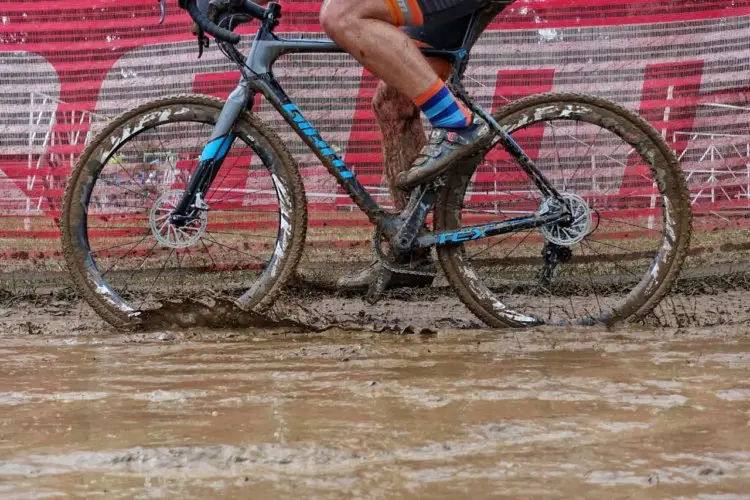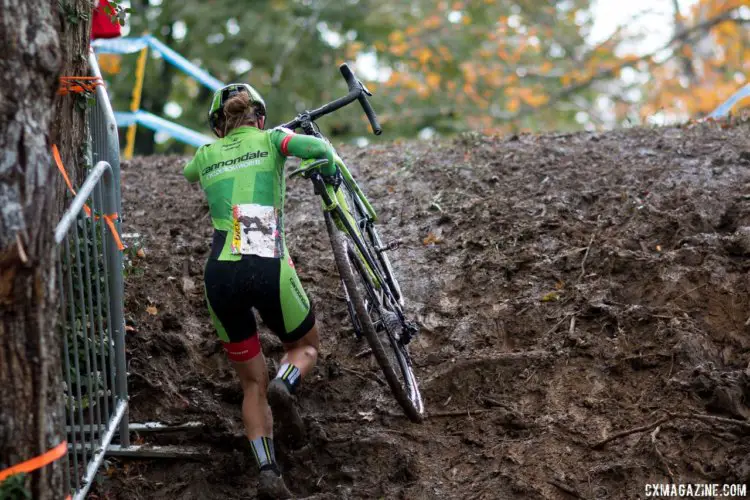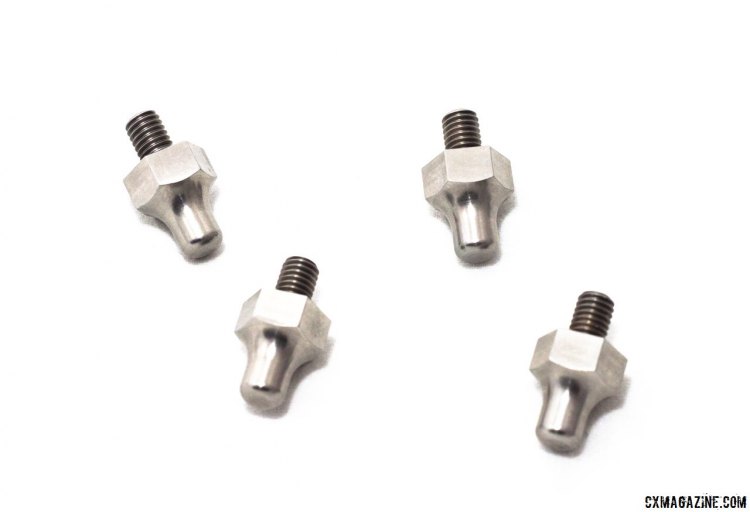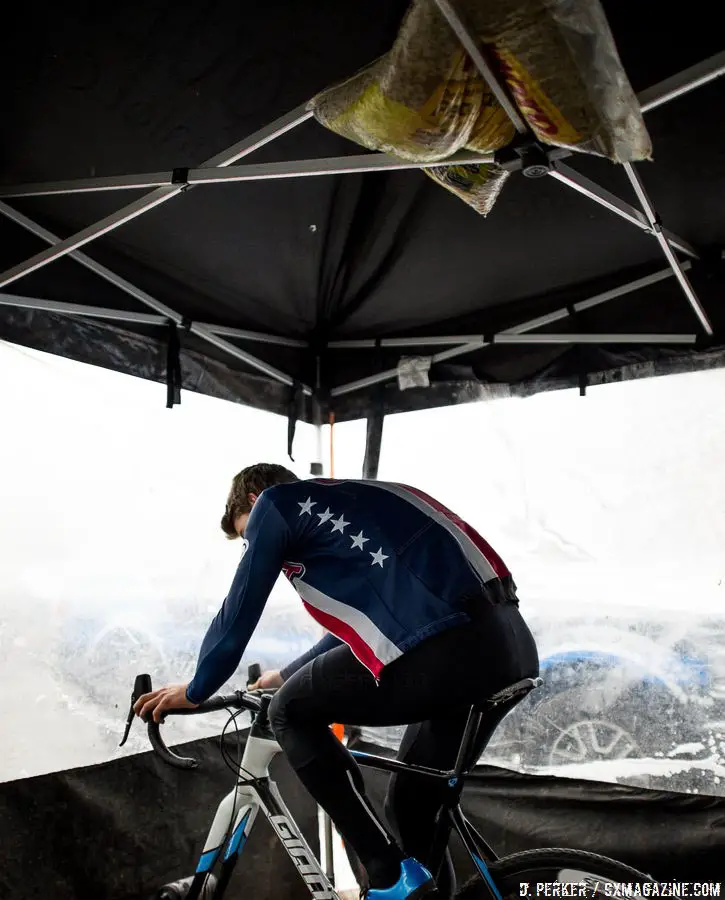Mud.
It’s what we think of as part of “real” cyclocross conditions. I’d like to think if Carl von Clausewitz wrote about ’cross and not war theory he’d say, “Everything is very simple in mud, but the simplest thing is difficult.”

Fall means mud and “real cyclocross conditions.” 2017 Derby City Cup. © D. Perker / Cyclocross Magazine
All the obstacles and difficulties of cyclocross are magnified on a muddy day. It can become very intimidating just to toe the line on a day like that. The easiest way to gain confidence in muddy conditions is to spend a lot of time riding in muddy conditions. But the only way to accumulate years of experience is to spend years gaining that experience. With that in mind, let me share with you the simplest—and largely inexpensive—ways I know of to deal with mud and the best advice I’ve been given over the years.
The single best piece of advice I’ve been given comes from Marc Vettori. “Half of being a mudder is telling yourself you’re a mudder.”
It’s still ’cross, it’s still riding a bike. Yes, things are harder. Maybe slick conditions aren’t your strongest area, but you can still do this, rain or shine. Often, I find that when people say “I’m no good at mud,” they envision the rest of the field floating through the mud mistake free. Everyone makes mistakes. Everyone. Don’t think you’re the only one making them, everyone is.
Often it’s a matter of who can make one less mistake or recover the best after making one. And, like Ellen, have a good laugh at yourself. If it weren’t happening to you, you’d probably find it pretty funny. Being able to depersonalize things is good for keeping your monkey brain in check and not being overwhelmed with emotion. Being able to laugh keeps you humble and lessens the penalty of “failure”. (You’re not failing, you’re just telling yourself you are.)

Telling yourself you are a mudder is half of being a mudder. Elite Women, 2017 Cincinnati Cyclocross, Day 1. © Cyclocross Magazine
What I’m getting at is mindset is so key to racing in the mud. Mud can result produce sheer chaos during races. There are a lot of things you simply cannot control. Take control of the things you can like your pre-race prep, course inspection and hitting the start line with properly working equipment, and put aside the worries about the things you can’t influence. Having faith you’ve prepared as well as you can should give you a good mental boost.
This, from Dr. Kristen Keim, got me through one of the most challenging weekends of my season: “Outcome is not in your control. What’s in your control is your effort and your intentions.”
That’s the mental side, what else is there? The first and easiest things to help in the mud are mud tires and toe spikes. It seems like courses are getting hotter and dryer and my dry-condition tires are seeing way more use than my mud tires these days. But when it’s 40°F and raining there’s, really no substitute for some quality mud tires. Maybe they need to be clinchers for you, but anything is better than nothing.
Don’t skimp by using mixed condition tires like an MXP or Baby Limus. For real mud, you need a full mud tire. Maybe it won’t see a lot of use, but when it does it’ll be worth every penny.
Here’s the last free mental tip. Green means go. The brown muddy line that gets burned in first is made by the early categories. That line is slick and will only get worse as more people ride it. People tend to forget they have every bit of the course to work with between the tape, and even past the tape. Look for the green grass that hasn’t been ridden to find more traction.

Find the green grass for a better riding line if you can. 2017 Derby City Cup. © D. Perker / Cyclocross Magazine
Start looking for lines and opportunities other people aren’t using. Learning how to execute this in detail involves going to a ’cross clinic, but the reader’s digest version is to increase the radius (Courtesy of Mark Legg Compton) of all the corners as much as you can.
Toe spikes are another great way to make your life easier on a muddy day. There are a wide variety of them. Most shoes, if they come with any, tend to come with plastic knob-shaped ones. These are about as ineffective as no spikes at all. Horst Engineering sells many styles of metal spikes. Their medium length is great if you can only get one pair. I leave a set of short spikes in almost all year long, moving to longer ones at the conditions warrant. The longer the spikes are the more, it changes the mechanics of clipping in, so get some practice in with them before a race.

In general, spikes can offer an advantage, most noticeable on a difficult run-up. © Cyclocross Magazine
Spare clothes can help a lot, especially if it’s raining or cold. Creature comforts matter on cold wet days. Going to the line with as much clean, dry clothing as possible makes your time in the start grid a lot more comfortable and you’ll have a better chance of not shivering by the time the gun goes off. If you can warm up in old clothing or non-team clothing, do that.
Even better are some shell layers to keep the wet and cold off your skin. A pair of rain pants and a rain jacket can be found for a relatively inexpensive cost, and rain pants keep your rear end relatively warm and dry while riding a wet course. You don’t need them for more than a few pre-ride laps, so they don’t have to be the latest and greatest in fit or technical fabrics. REI has some great choices. Shoe covers are great for keeping your feet cleanish and dryish while warming up, or use your old, nearly worn out shoes as a second set just for this purpose. Defeet makes some great covers and they aren’t that expensive. And you won’t cry when you tear them up walking around in them.

A nice jacket can keep you warm before your race. Denzel Stephenson, with his Team USA jacket, spinning his legs on Saturday. 2017 Cyclocross National Championships, © D. Perker / Cyclocross Magazine
Lastly, gloves. Experienced ’crossers have gloves for every combination of temperature and conditions. Often multipe pairs of gloves sit unused in our quiver, but it is great to have them the ONE TIME we need them to make it all worth it. You want warm hands so you can be comfortable, but you also need good bar feel for steering and braking. Everyone will have a glove suggestion. For wet cold days, I really like the Endura neoprene gloves. They’re thin enough to drive in but very, very warm. But ask around, ’crossers love to talk gloves.
Mud is hard, no doubt, but it’s something you can do. Crossers don’t get to pick and choose the courses they race, unlike other cycling disciplines. Come in with a good attitude, be prepared to laugh at yourself, and start picking away at the easy purchases that will make the most difference in your experience.




























